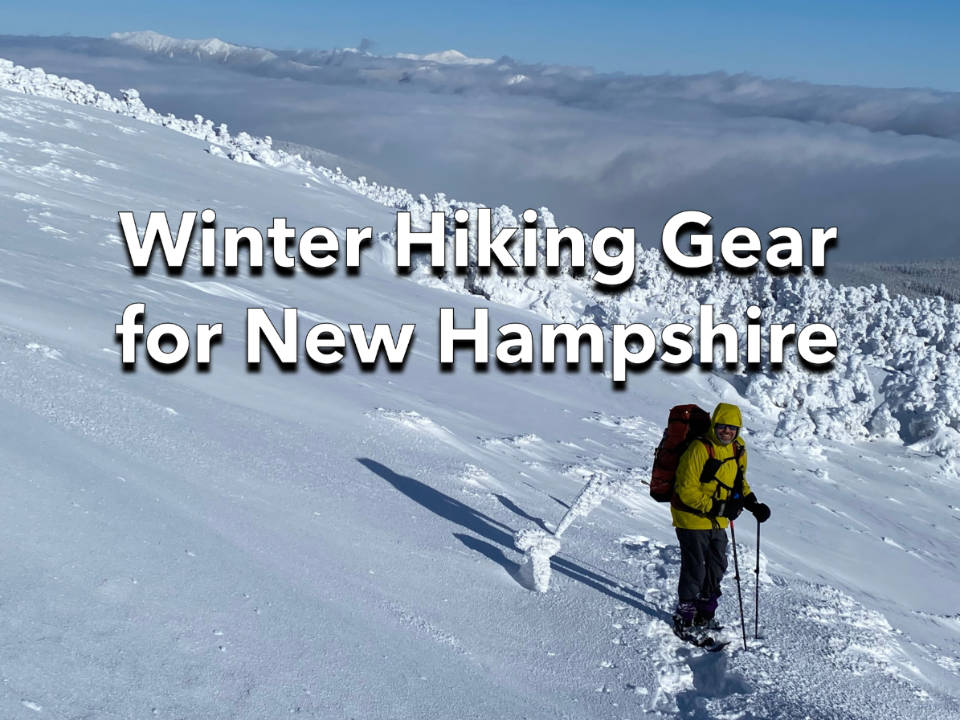When gearing up for winter day mountaineering within the White Mountains of New Hampshire, in addition to Maine and Vermont, you want footwear, clothes, and traction aids that can be utilized throughout a variety of temperatures, wind speeds, solar, precipitation varieties, and floor circumstances. For instance, typical winter climate contains:
- Temperatures: from 40 levels down to twenty under zero (Fahrenheit)
- Wind speeds: as much as 40 mph (over that, you get knocked down)
- Sunlight: from intense sunshine and snow glare to heavy clouds or dense forest cowl
- Precipitation varieties: together with blowing snow, freezing fog, sleet, freezing rain, and rain
- Surface circumstances: starting from deep snow to reveal rock, naked floor, packed trails, powder, frozen our bodies of water, and comfortable or arduous ice
Layering Clothes
In addition, that you must gown for a variety of exercise ranges, comparable to if you find yourself exerting your self and producing numerous physique warmth or if you find yourself at relaxation and must bundle up.
The really useful method for winter dressing is so as to add clothes layers while you get chilly and take off layers while you begin to sweat. Sweating ought to be averted in winter as a result of damp clothes, significantly baselayers, will chill you while you cease shifting. Take off layers should you begin to sweat or decelerate your tempo to generate much less physique warmth.
When beginning a hike in winter, you’ll in all probability be carrying gloves, a hat, lengthy sleeve jersey, lengthy underwear, boxer jocks, hardshell or softshell pants, a fleece pullover, a hardshell jacket, heat socks, insulated boots, and excessive gaiters. After about quarter-hour, you’ll in all probability take off your hardshell and unzip your pants to vent physique heat. That’s known as layering and it happens when somebody in your group shouts out “layer break!”

Winter Day Hiking Gear List
The following day winter day mountaineering clothes and kit will hold you protected and comfy in below-treeline circumstances. Below-treeline hikes are normally protected by forests and are hotter and fewer windy than above-treeline hikes, that are on high of uncovered mountains or ridgelines.
- Footwear
- Insulated mountaineering boots
- Warm socks
- High gaiters
- Hats
- Lightweight fleece or wool hat
- Heavyweight fleece or wool hat
- Gloves
- Lightweight fleece or wool gloves
- Waterproof shell mitts or gloves, with insulated liners
- Jackets
- Puffy insulated jacket with hooked up hood
- Waterproof and windproof jacket with hooked up hood
- Pants
- Rain pants which might be waterproof and windproof
- Softshell pants which might be reasonably windproof
- Base-Layer Insulation (wool or artificial solely)
- Long sleeve jersey
- Long underwear (good for individuals who run chilly)
- Boxer jock underwear to stop chafing
- Mid-Layer Insulation
- Fleece jacket, fleece pullover, fleece vest, insulated vest, or softshell jacket (a minimum of one, probably a number of)
- Winter traction aids
- Microspikes
- Snowshoes (relying on circumstances)
- Crampons (relying on circumstances)
- Water Bottles
- Two or three 1-liter wide-mouth water bottles (hydration system hoses freeze up and ought to be averted)
- Water bottle insulation, if bottles are saved outdoors your backpack
- Backpack
- 35-45 liter backpack with facet compression straps or a shovel pocket for attaching snowshoes and microspikes to the pack
- Extra webbing straps as wanted for attaching extra gear
- 10 Essentials
- Map
- Compass
- Whistle
- Headlamp (1 or 2)
- Personal first help package
- Fire beginning supplies (wax in paper egg containers make one of the best firestarter)
- Small knife or multi-tool
- Gear restore provides
- High-energy snacks that gained’t freeze
- Sunglasses and sunscreen
- Toilet paper
- Survival Gear – this may be distributed amongst mountaineering group members, or carried if mountaineering alone
- Sleeping bag
- Sleeping pad
- Lightweight bivy sack or tent physique with out tent poles
- White gasoline range, gas, pot, range base
- Group first help package
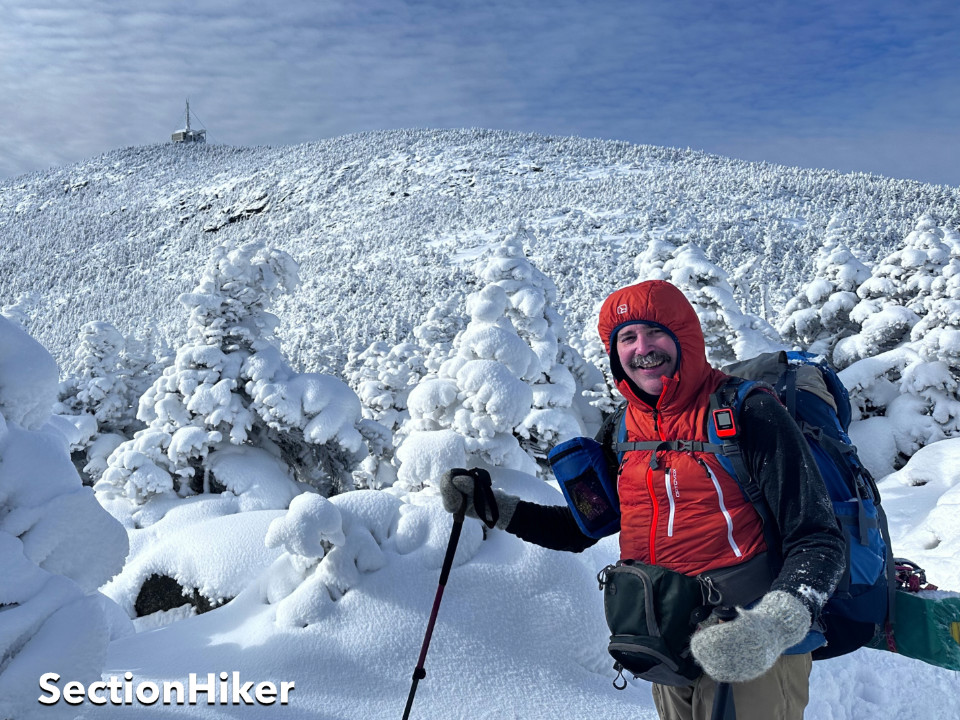
Extra Gear for Above-Treeline Day Hikes
If you’re headed above treeline on a day hike, you’ll typically need to carry additional wind safety on your face and beefier traction aids, like full crampons. Avalanche instruments are not often wanted in New Hampshire until you might be mountaineering in high-risk mountain areas.
- A face masks or mixture face masks/balaclava
- Snow goggles
- Crampons
- Ice ax (relying on the route)
- Avalanche shovel, beacon, and probe in hazardous terrain
Winter Hiking Clothing and Gear Guide
While gear lists are helpful, I’ve additionally supplied some recommendation under about what to search for when buying gear for winter use to steer you in the fitting route in regards to the capabilities you need in winter mountaineering gear. I’ve used each single merchandise listed under so I do know what’s good and what’s not good.
Insulated winter boots
Most folks day hike in “soft” insulated winter mountaineering boots that would not have a detachable liner and are appropriate with microspikes, snowshoes, and crampons which might be appropriate with non-rigid boots. These can be found with 400-gram insulation and 200-gram insulation. This refers back to the thickness of the insulation used, not its weight. Boots with 400-gram insulation will hold you heat to twenty under zero levels (F), whereas boots with 200-gram insulation are good to about 10-20 levels above zero levels (F). These temperatures assume you might be strolling, not standing round. If you propose on mountaineering the place temperatures get under 10F-20F levels, I like to recommend 400g insulated winter boots. Otherwise, a 200g insulated boot ought to be enough. Here are some suggestions:
You can even put on mountaineering boots which have a inflexible sole able to getting used with crampons for mountain climbing and mountaineering. These are tougher to stroll in for any distance, however some can be found with detachable liners that are helpful for winter backpacking as a result of you possibly can dry them in a sleeping bag at evening. Avoid so-called Pack Boots, that are much less comfy for vigorous mountaineering and are too giant to be used with microspikes and most snowshoes.
Warm socks
Most hikers put on heavier wool socks in winter than throughout different occasions of the 12 months, however that is an space of non-public desire, and the sock “systems” folks use range extensively. Sock liners are optionally available however will be useful in case you are blister-prone. Whatever mixture you utilize, make it possible for there may be loads of house in your boots to wiggle your toes round as this will increase blood circulation and foot heat. We suggest:
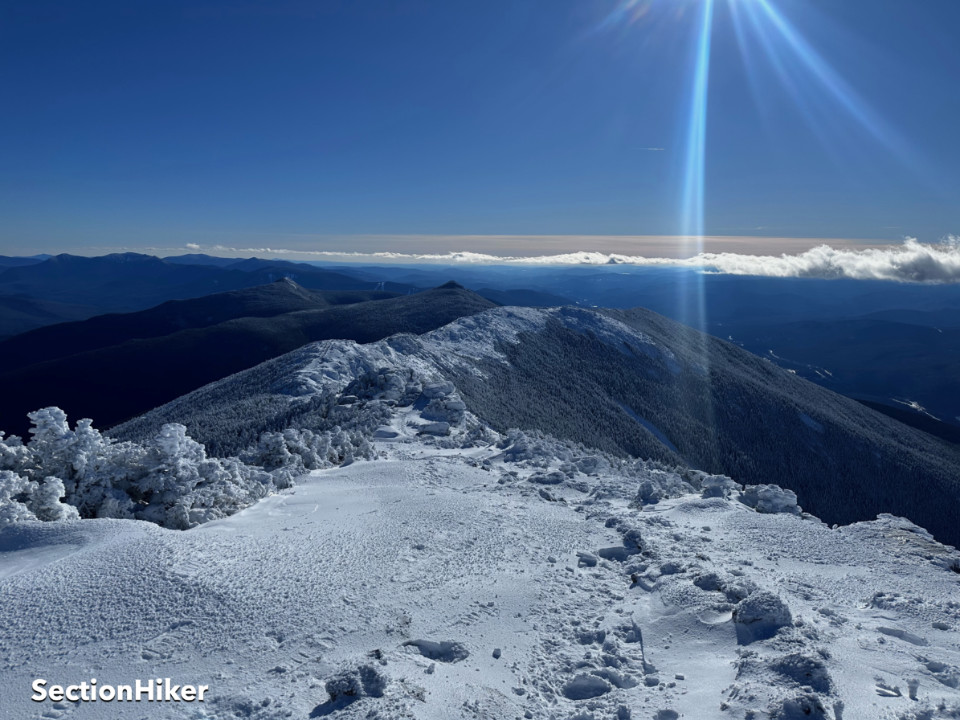
High gaiters
High gaiters assist stop snow from coming into your boots or making your socks moist and supply additional insulation under your knee. If you utilize crampons, in addition they shield your ankles from self-inflicted wounds while you tire. Avoid gaiters that shut with zippers as a result of they break shortly. Look for gaiters that seal round your leg utilizing velcro or snaps as a substitute. We suggest:
Hats
A minimal of two hats is really useful for winter day hikes: a light-weight wool or artificial hat for high-exertion actions and a hotter, heavier-weight hat for later within the day when temperatures drop. You’ll in all probability sweat a minimum of one among them out. We suggest:
Gloves
A minimal of two pairs of gloves is really useful, though hikers typically deliver three or 4 pairs if their fingers sweat lots whereas mountaineering. Experiment with this. You’ll be glad to have extras should you moist out your gloves with sweat.
One pair of gloves ought to be modular with an unlined outer waterproof/breathable shell layer and an interior insulating glove liner. Mitts present extra heat than gloves, however gloves present extra dexterity. One method is to make use of an insulating fleece liner glove inside a water-resistant mitten shell to supply dexterity and heat. When buying a modular mitten system (mitten plus liner) or a mitten shell, I like to recommend getting ones with wrist gauntlets, which can insulate your wrists and hold your fingers hotter. If your fingers are too heat with a mitten shell and liner they usually begin to perspire, you possibly can take away the mitten shell and pack it away till it’s wanted. We suggest the next modular mitt methods and mitten shells:
I normally carry a number of pairs of cheap REI fleece gloves so I can swap them out if one pair will get moist or soaked by perspiration. Hint: Buy a number of pairs, all in the identical coloration, so you possibly can swap in a substitute should you lose one among a pair or put on it out.
If that you must grip an ice axe in your hikes, you’ll additionally need to store round for an insulated high-dexterity glove so that you maintain the choose within the ice-axe ready-position. A mitten shell doesn’t present sufficient dexterity to wrap your fingers across the choose and a glove liner doesn’t present sufficient insulation from the chilly steel. Black Diamond has some good gloves which might be apporpriate, together with the Black Diamond Punisher Glove.
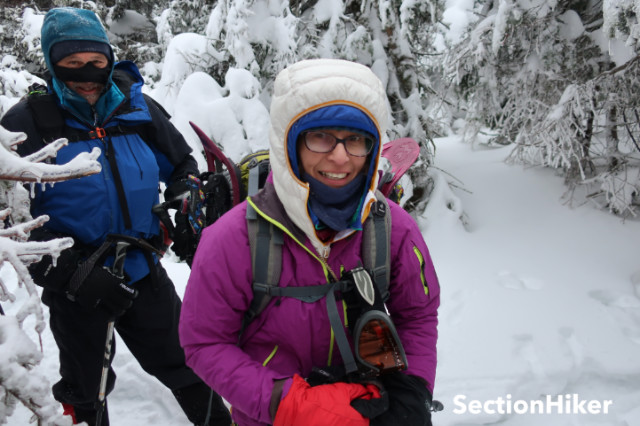
Puffy Insulated Hooded Jacket
When you’re taking a break throughout a winter hike and have stopped shifting, it’s finest to drag an enormous puffy insulated jacket out of your backpack and put on it over your different garments to remain heat. You’ll desire a parka-weight jacket and not a light-weight 3-season jacket. This coat ought to be sufficiently heat that you can stand round in it for a couple of hours if somebody in your group has an accident and that you must stick with them till assist arrives. You need one thing with an built-in hood that may hold you toasty heat in frigid climate. We suggest:
Lightweight insulated jackets just like the Mountain Hardwear Ghost Whisperer Jacket are too light-weight.
Hard Shell or Rain Jacket
You additionally need to carry a windproof and waterproof rain jacket/or hardshell with an adjustable hood that may be worn when you are mountaineering. They don’t have built-in insulation, however they’ll defend you from excessive winds and lure the warmth held by your mid-layer clothes. Look for jackets with a minimum of two exterior pockets to stash hats and gloves. Hardshell jackets or rain jackets with pit zips present probably the most flexibility for regulating your temperature. Tthe Outdoor Research Foray 3L with full torso-length facet zips is a superb choice that I take advantage of in winter. The ladies’s model is named the Outdoor Research Aspire 3L Jacket.
Hard Shell Pants or Rain Pants
Hardshell or rain pants are utterly windproof and waterproof. Many folks discover it useful to make use of pants which have full zips alongside the perimeters to assist vent additional warmth whereas mountaineering. Ankle zips are required at a minimal, so you possibly can put them on or take them off with out having to take off your boots. Test this out earlier than you hike with them. Some hikers put on hardshell pants as their main pant layer, with lengthy underwear beneath for heat. Marmot Precip Full Zip Pants are a superb, economical full-zip waterproof pant choice.
Softshell Pants
Many hikers, myself included, choose carrying softshell pants in winter as a result of they’re extra breathable and form-fitting than full-zip hardshell pants. If that’s the case, you continue to must deliver a pair of arduous shell pants for defense in opposition to sustained precipitation and excessive winds since most softshell pants are water and wind-resistant however not waterproof or windproof. Softshell pants are usually a lot hotter than hardshell pants, so that you typically don’t must put on lengthy underwear with them besides in very chilly climate. REI makes a cost-effective softshell pant known as the Men’s Activator Pant (and Women’s Activator Pant) that I take advantage of and suggest.
Base layer insulation
Most winter hikers put on a wool or artificial base layer consisting of an extended sleeve jersey, lengthy underwear pants, and a few sort of boxer or bikini underwear underneath that. All of your base layers have to be artificial or wool and never cotton as a result of they’ll dry sooner and gained’t trigger chafing in the event that they get damp.
The most vital consider selecting a base layer is that it ought to be wicking in order that it transports sweat away out of your pores and skin to the subsequent highest layer of your clothes. Lightweight and skinny layers do that higher than heavier layers, however once more that is an space of non-public style. Patagonia Capilene Cool, obtainable in jerseys and lengthy underwear, is a superb choice. A Smartwool Merino 150 LS Baselayer shirt can also be a sensible choice. If you run actually chilly, strive a fishnet-style jersey from Brynje. They actually do work!
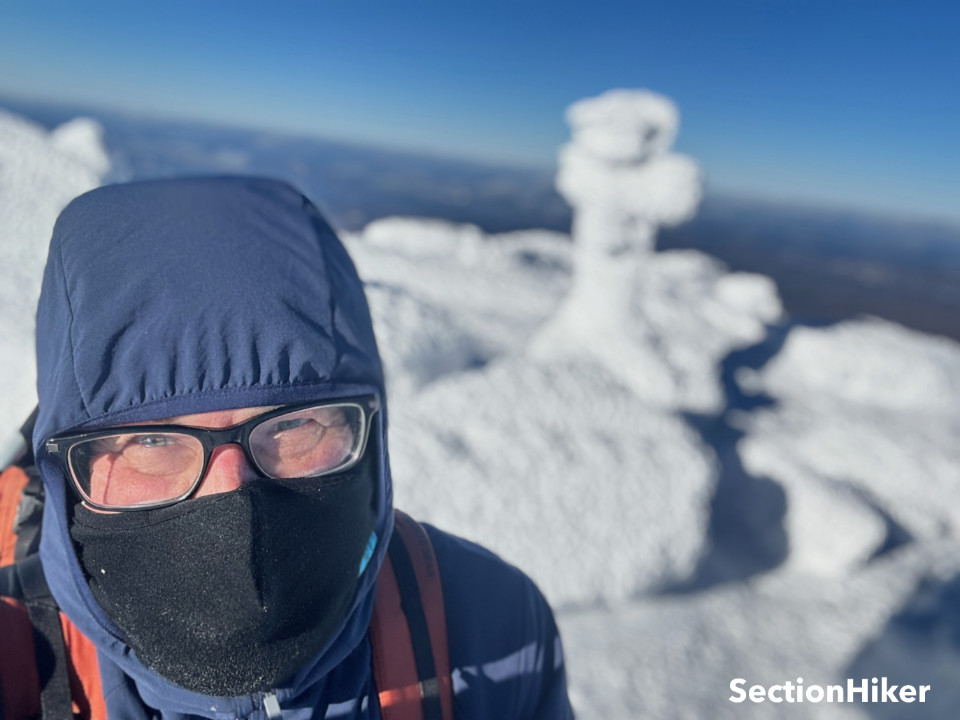
Mid-Layer Insulation
The operate of your mid-layer is to wick moisture out of your baselayer and to supply insulation so that you’ll be hotter. There are many choices obtainable, however fleece or wool jackets, hoodies, or jackets normally work finest and might typically be worn as an outer layer in hotter climate. You can even increase a mid-layer with a softshell jacket or an insulated vest for extra heat relying on whether or not you run scorching or chilly.
We suggest:

Winter Traction-Aids
The traction aids that you just deliver on a hike are more likely to range, relying on the climate and whether or not you might be mountaineering on a path that others have hiked beforehand and packed down. Most hikers carry microspikes on all hikes as a result of they supply additional traction on packed snow and ice they usually’re fairly light-weight. Snowshoes may be required, significantly on much less traveled trails or after a snowfall. Heavier-duty crampons may be required for steep routes coated with rock or thick ice, whereas snowshoes present floatation for mountaineering by unconsolidated snow. It’s not unusual so that you can have to hold some or all of those on a hike, relying on the place you go and what number of different folks use the paths you comply with. When shopping for snowshoes for mountainous terrain you need ones which have a televator elevate underneath the heel, which makes it simpler to climb hills. We suggest the next traction aids, that are appropriate with all varieties of winter boots.
Water Bottles/Water Bottle Insulators
Hydration reservoir hoses freeze very simply in chilly temperatures, so it’s finest to hold two or three 1-liter wide-mouth bottles on winter hikes since narrow-mouth bottles additionally freeze shut extra simply. If you carry your water bottles outdoors of your backpack, it’s finest to retailer them the other way up in an insulated sleeve so the cap gained’t freeze shut. White wide-mouth Nalgene bottles are one of the best for winter use as a result of they don’t crack.
For insulation, strive insulated Nalgene water bottle sleeves or 40 under Neoprene Bottle Boots. Insulated Hydroflask 32oz. steel bottles additionally work however are heavier. You can even retailer your bottles in a wool sock inside your pack, surrounded by your down parka. Boil your water earlier than placing it into the bottles and it’ll keep heat for a very good a part of the day. Add tea, electrolytes, or different flavorings to make it fascinating to drink so that you keep hydrated.

Winter Dayhiking Backpacks
You’ll desire a 30-50 liter backpack for winter day mountaineering since you’ll be carrying extra additional garments, meals, and water than the remainder of the 12 months. Winter packs ought to have plenty of exterior attachment factors, daisy chains, and facet compression straps to which you’ll connect traction aids comparable to snowshoes, crampons, or microspikes. These are both too giant to pack inside a backpack, they’ve sharp factors that may slice up your additional packed clothes, or they are going to be encrusted with snow and finest saved separate. A full complement of traction aids can add as a lot as 6-8 kilos to your backpack load, so that you’ll desire a pack with a body that may carry the additional weight in your hips and never in your shoulders.
Daisy chains, that are webbing loops discovered on shoulder straps or the perimeters of a pack, are good for hooking gear, together with water bottles or Nalgene bottles crammed with bite-size snacks that you could shake into your mouth. It’s additionally handy to have a high lid on a winter backpack with a number of pockets to retailer gear you need simply at hand like your headlamp, additional hats, extra snacks, and gloves.
The following backpacks are glorious for winter day hikes:
10 Essentials
The 10 necessities are simply as vital in winter as throughout the remainder of the 12 months, maybe extra so, since winter mountaineering requires extra self-sufficiency.
A map and compass are vital as a result of it’s simple to lose one’s method, path blazes are sometimes buried in snow, and there are far fewer landmarks seen in winter when all the things is roofed in white. A plastic whistle is healthier than a steel one which can freeze to your lips, and helpful should you get misplaced as a result of it’s louder than a human voice. You ought to use lithium batteries in your headlamp and different digital gadgets as a result of they’re immune to chilly temperatures: nickel-metal hydride and alkaline batteries drain a lot sooner in chilly climate. Rechargeable headlamps are additionally okay since most have lithium batteries. You may additionally need to carry two headlamps since you’ll be mountaineering after sundown as a result of there are so few hours of daylight.
While you should buy industrial first help, gear restore, and fire-starting kits, they’re additionally simple to make by your self at dwelling. It additionally helps to deliver some sort of multi-tool or plastic ties with you on a winter hike to restore gear, particularly traction aids which take plenty of abuse. Sun safety, together with sun shades and sunscreen, is vital to hold as a result of it’s very simple to get a sunburn, from gentle mirrored off the snow.
Survival Gear
If you’re winter day mountaineering alone, it’s vital to deliver additional insulation together with a sleeping bag and sleeping pad as a way to stop hypothermia in case you are immobilized and that you must survive till assist arrives. A 20-degree sleeping bag, a foam accordion sleeping pad like a Therm-a-rest Zlite, and a light-weight bivy sack will normally suffice to maintain you alive should you additionally placed on the entire clothes you’re carrying. These will be cut up amongst totally different hikers if touring as a gaggle.
If you must spend an surprising evening out, you additionally must have a way of melting snow to create consuming water. While carrying a liquid gas range like an MSR Whisperlite and a cookpot is probably the most dependable method of doing this, a Jetboil can even work should you can hold the gas canister heat. Hypothermia is accelerated by dehydration and might have dire penalties. When mountaineering in a gaggle, this gear is normally distributed between group members, in any other case, you’ll in all probability want an even bigger backpack to hold all of it.

Extra Gear for Above Treeline Hikes
For above-treeline mountaineering, your greatest priorities are additional wind safety on your face and additional traction to stop uncontrolled slides on ice and snow. The best strategy to shield your face is to make use of a balaclava with a totally built-in facemask just like the Serius Comboclava. You’ll want to mix that with ski goggles to guard your eyes from blowing snow and forestall them from freezing shut. Practice carrying these earlier than you get above treeline as they’ll fog simply.
For additional traction, you’ll need to purchase toothier crampons and probably an ice ax. This is a reasonably superior stage of winter day mountaineering, so it’s finest to learn to use these instruments from a certified teacher, both a mountaineering information or in one of many winter mountaineering colleges run by out of doors golf equipment within the northeast such because the Appalachian Mountain Club or the Adirondack Mountain Club.
See Also:
SectionHiker is reader-supported. We solely make cash if you buy a product by our affiliate hyperlinks. Help us proceed to check and write unsponsored and unbiased gear critiques, newbie FAQs, and free mountaineering guides.
About the writer
Updated November 2024.




